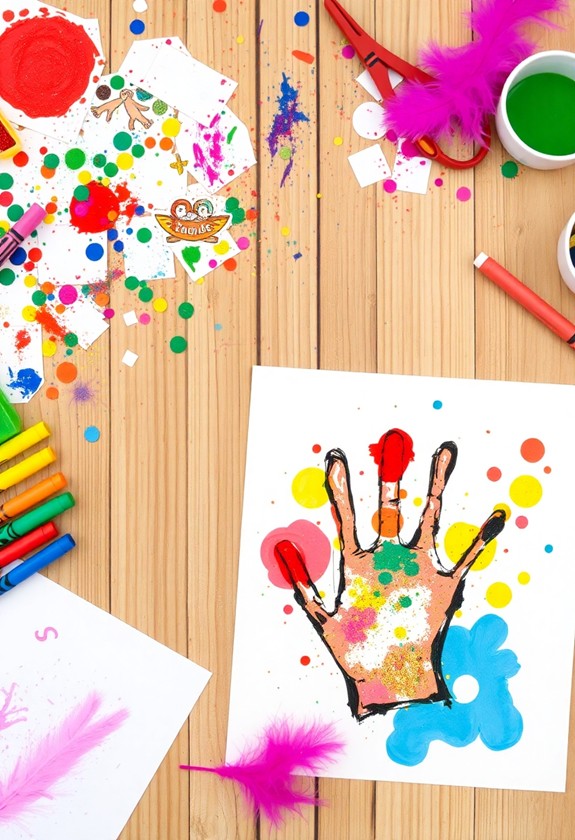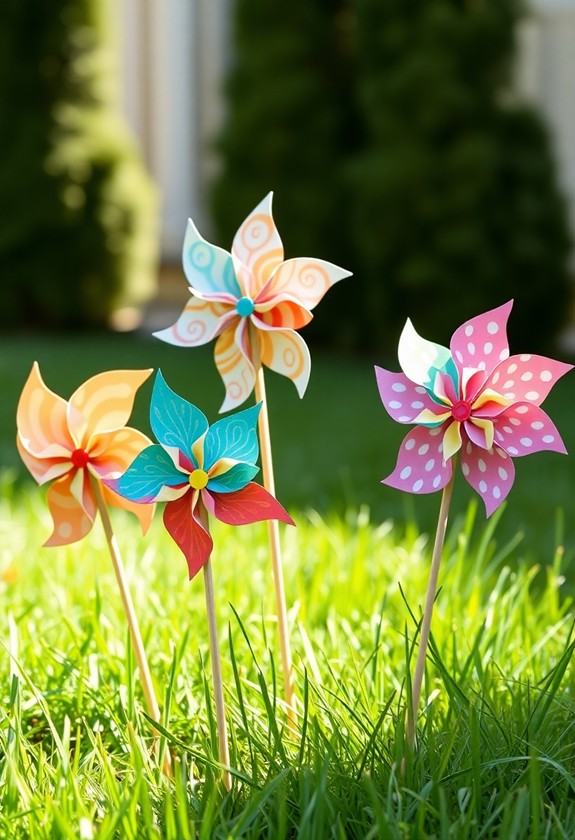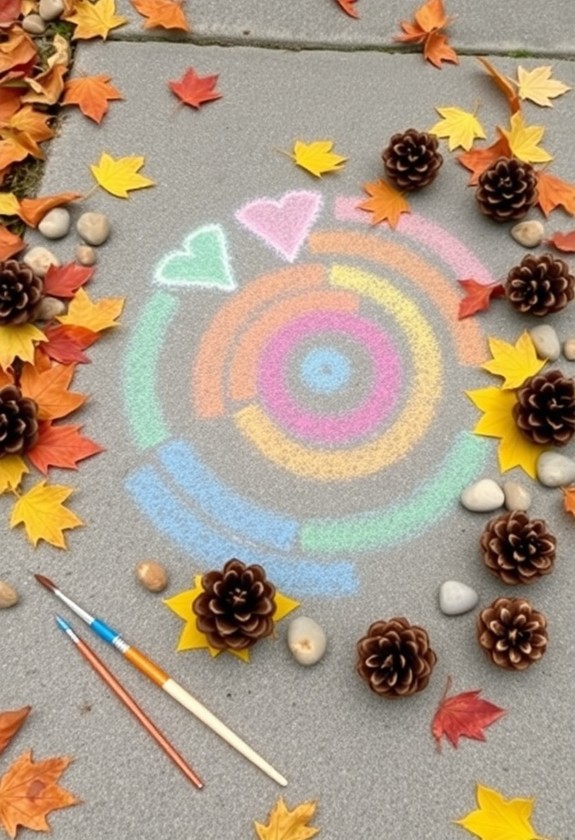Looking for fun, budget-friendly art projects for your kids? You're in luck! Try these seven awesome activities: finger painting with homemade colors, crafting paper plate masks, creating nature collages, building recycled material sculptures, molding DIY playdough masterpieces, discovering sponge painting techniques, and experimenting with crayon resist watercolors. These activities will spark your child's creativity, develop their fine motor skills, and provide hours of entertainment – all without breaking the bank! From messy play to intricate designs, there's something for every young artist. Get ready to release your child's inner Picasso and turn your home into a lively art studio. The colorful possibilities are endless!
Creative Highlights
- Finger painting with homemade colors made from cornstarch and food coloring provides safe, messy fun for toddlers.
- Paper plate mask making enhances creativity and fine motor skills using household items and crafting supplies.
- Nature collage creation combines outdoor exploration with artistic expression using free materials from the environment.
- Recycled material sculpture building promotes environmental awareness and problem-solving skills using clean household recyclables.
- DIY playdough art projects offer non-toxic, imaginative play opportunities with homemade dough from flour, salt, and water.
Finger Painting With Homemade Colors
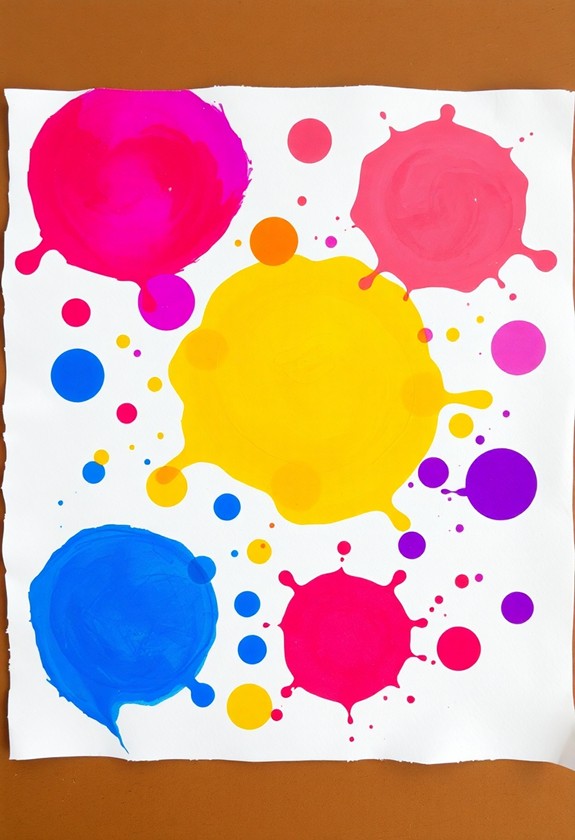
Original Text Rewritten:
Whilst store-bought finger paints can be expensive, you can easily make your own at home using common kitchen ingredients. It's time to get your hands messy and have some colorful fun! This activity is perfect for younger toddlers as it's simple and doesn't require scissors, promoting safety during still encouraging creativity.
What you'll need:
- 1 cup cornstarch
- 1 cup cold water
- 3 cups boiling water
- Food coloring
Let's get painting:
- Mix the cornstarch and cold water in a bowl until smooth.
- Slowly add the boiling water, stirring constantly. The mixture will thicken – that's perfect!
- Divide the mixture into smaller containers and add different food coloring to each. Voila! You've got homemade finger paints!
Now, it's time to release your inner Picasso! Spread out some paper on the table or floor, and let your kids go wild. They can use their fingers, hands, or even feet to create masterpieces. Don't forget to join in the fun – it's a great way to bond and get creative together!
Paper Plate Mask Making
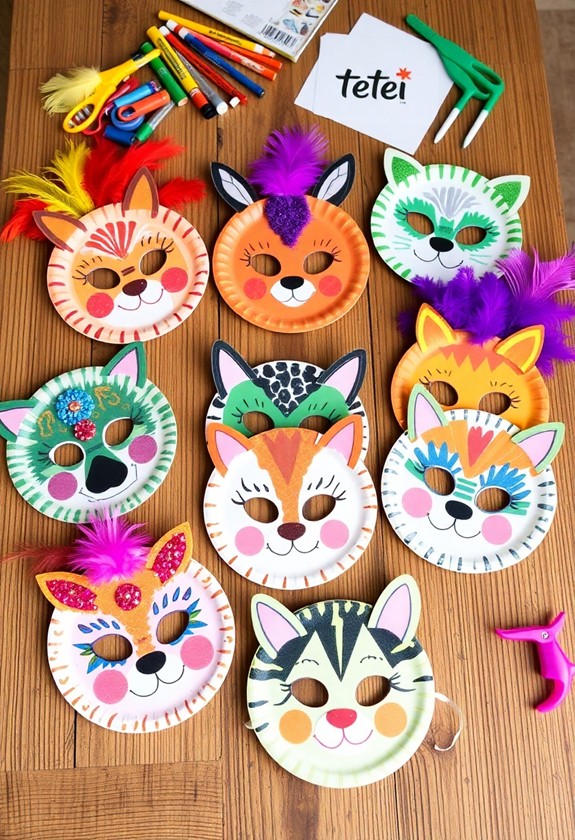
Bursting with creative potential, paper plate masks offer a fun and affordable way to spark your child's imagination. You'll love how easy it is to transform a simple paper plate into a colorful character or animal! To get started, gather your supplies: paper plates, scissors, elastic string, and decorating materials like markers, paint, or crayons. This activity is perfect for enhancing fine motor skills and promoting creative expression in toddlers and young children.
First, help your child cut eye holes in the plate. Don't worry if they're not perfect – it's all part of the fun! Next, it's time to let their creativity shine. They can draw directly on the plate or glue on colorful paper shapes. Feathers, sequins, and googly eyes make great additions too!
For a 3D effect, encourage your kid to cut and fold parts of the plate. They might create a beak for a bird or ears for a cat. The possibilities are endless! Once the masterpiece is complete, attach the elastic string. Voila! Your little artist can now become their creation.
But wait, there's more! Why not host a mask parade? It's a great way to show off their handiwork and have a giggle-filled afternoon!
Nature Collage Creation
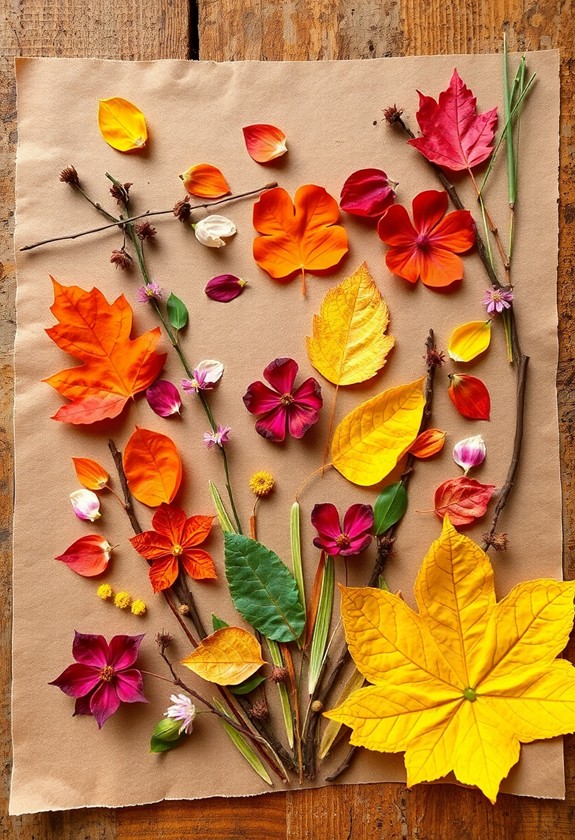
Nature collages offer a delightful way to combine outdoor exploration with artistic expression. It's time to get creative with Mother Nature's art supplies! First, grab a sturdy piece of cardboard or paper for your base. Now, head outside and start collecting treasures! This activity not only encourages creativity but likewise develops fine motor skills as children handle and arrange various natural objects. It's a perfect blend of sensory play and artistic expression.
What to collect:
- Leaves of different shapes and colors
- Twigs and small branches
- Colorful flower petals
- Interesting pebbles or rocks
- Feathers (if you're lucky!)
- Acorns, pinecones, or seeds
Once you've gathered your natural goodies, it's time to create! Arrange your finds on the base, playing with patterns and shapes. When you're happy with the design, glue everything down. Don't forget to press flowers and leaves between heavy books first if you want them flat!
Want to add some pizzazz? Try these leaf-velous ideas:
- Create a tree with twigs and leaf "leaves"
- Make a flower garden with petals and pebble stems
- Spell out your name using nature's alphabet
Your nature collage will be tree-mendous! And the best part? It's a unique masterpiece that changes with the seasons. So branch out and let your creativity bloom!
Recycled Material Sculpture Building
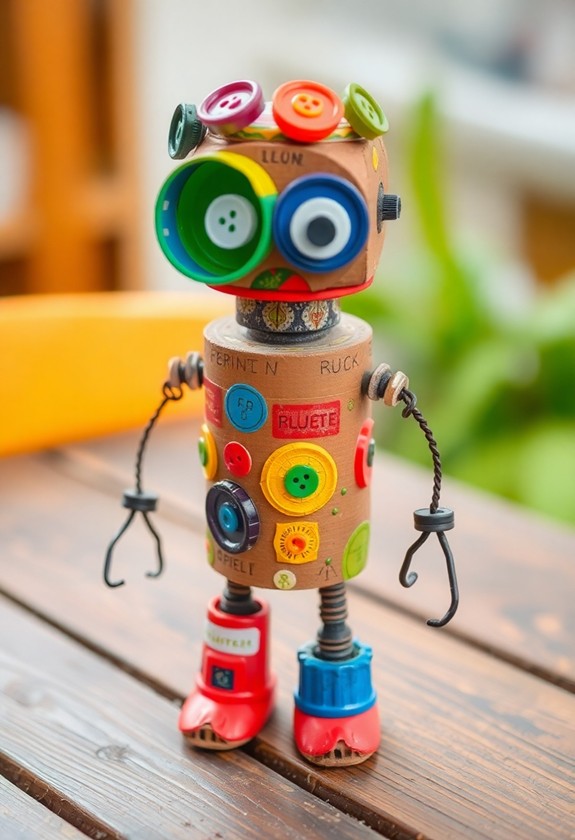
Ready to turn trash into treasure? Recycled material sculpture building is a fantastic way to release your child's creativity during being kind to the environment. It's time to raid the recycling bin and gather those empty containers, cardboard boxes, and plastic bottles! This activity not only improves fine motor skills but also encourages problem-solving as children figure out how to connect different materials.
Here's how to get started on your recycled masterpiece:
- Collect materials: Gather a variety of clean, dry recyclables like cardboard tubes, bottle caps, egg cartons, and colorful packaging.
- Plan the design: Sketch out ideas or let your imagination run wild! Will it be a robot, a magical castle, or an abstract creation?
- Assemble the pieces: Use child-safe glue, tape, or string to connect the parts. Don't be afraid to mix and match!
- Decorate: Add paint, markers, or stickers to bring your sculpture to life. The sky's the limit!
DIY Playdough Art Projects
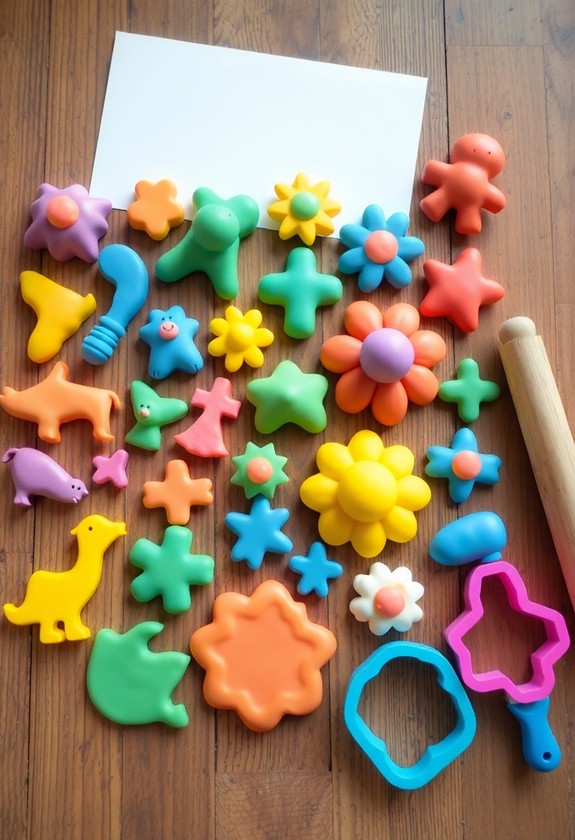
Who says you need expensive materials to create enchanting art? DIY playdough is a magical medium that'll have your kids sculpting up a storm in no time! Let's plunge into this dough-lightful world of creativity!
Making the Playdough:
First things first, whip up a batch of homemade playdough. It's super easy! Mix flour, salt, water, and food coloring in a bowl. Knead it until it's smooth, and voila! You've got a rainbow of moldable fun at your fingertips. This non-toxic alternative is perfect for preschoolers, promoting fine motor skills and creative exploration.
Sculpting Time:
Now, let your imagination run wild! Create miniature animals, build a colorful garden, or fashion tiny food items. The possibilities are endless! Encourage your little artists to mix colors and textures for unique effects.
Playdough Prints:
Here's a neat trick – press objects into the dough to make cool imprints. Leaves, buttons, or even toy dinosaur feet can create amazing textures!
Playdough Mosaics:
Roll out thin "snakes" of different colors and arrange them to form pictures. It's like painting, but with squishy, 3D materials!
Sponge Painting Techniques
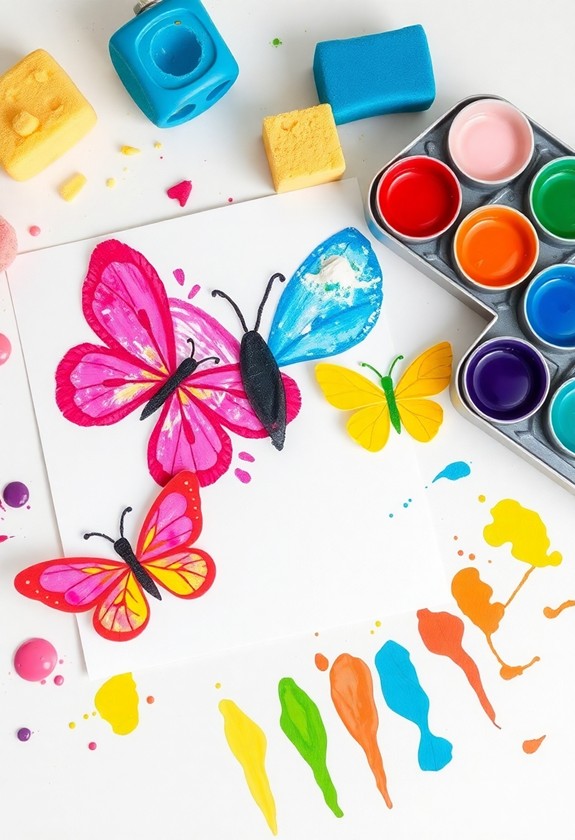
Let's plunge into the world of sponge painting! This fun, messy technique is perfect for kids who love to investigate textures and colors. You'll be amazed at the cool effects you can create with just a few simple tools.
What you'll need:
- Natural or synthetic sponges (different shapes and sizes)
- Washable tempera paints
- Paper or canvas
- A splash mat or old newspapers
To get started, dip your sponge in paint and dab it onto your paper. Experiment with different pressures and motions to create unique patterns. Try twisting, stamping, or dragging the sponge across the surface. Mix colors for a rainbow effect, or use a single hue for a monochromatic masterpiece!
Want to take it up a notch? Cut sponges into fun shapes like stars or hearts. Or, use a sponge to create textured backgrounds for other art projects. The possibilities are endless!
Crayon Resist Watercolor Exploration
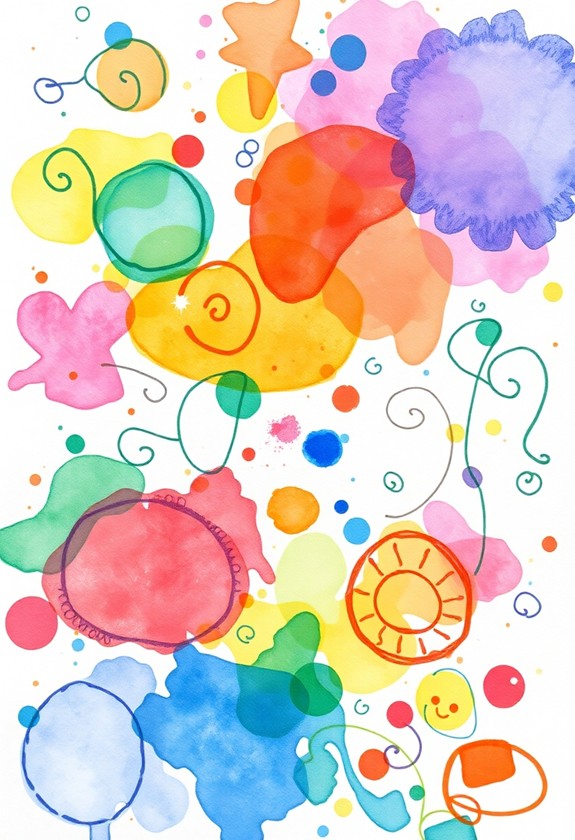
Now that we've explored the world of sponge painting, it's time to unveil another magical art technique: crayon resist watercolor. Get ready for a colorful adventure that'll make your artwork pop!
What you'll need:
- White paper
- Crayons (the brighter, the better!)
- Watercolor paints
- Paintbrush
- Water
Let's create:
- Start by drawing a fantastic design on your paper with crayons. Go wild! Swirls, shapes, or even a secret message – it's up to you!
- Now for the real magic! Grab your watercolors and brush. Dip your brush in water, then paint, and watch as the colors glide around your crayon lines. It's like they're playing hide-and-seek!
- Keep painting until you've covered the whole paper. The crayon areas will "resist" the paint, creating a cool effect.
- Let your masterpiece dry, and voila! You've just created a wax-cellent work of art!
This activity is not merely fun but also teaches you about how different materials interact. Plus, it's a great way to experiment with color mixing. So, grab your supplies and let your imagination run wild!
Curious Little Questions
How Can I Protect My Furniture and Floors During Messy Art Activities?
Protect your precious surfaces, art warriors! Here's your battle plan: Cover tables with old newspapers or plastic tablecloths. They're your first line of defense! For floors, lay down drop cloths or repurpose those cardboard boxes. Feeling fancy? Use washable shower curtains! Don't forget to suit up your little artists in smocks or old t-shirts. And here's a fun trick: create a designated "art zone" with painter's tape on the floor. It's like a magical forcefield for messy masterpieces!
What Age Groups Are These Activities Suitable For?
You'll be thrilled to know these activities are perfect for a wide range of ages! Most are suitable for kids from 3 to 12, but you can easily adapt them. For younger artists, simplify steps and offer more guidance. Older kids can tackle more complex projects independently. Remember, it's all about having fun and releasing creativity! Mix it up with age-appropriate challenges, and don't forget to join in – after all, you're never too old for art adventures!
Are There Any Alternatives for Children With Sensory Sensitivities?
Guess what? You're in for a treat! There are plenty of fantastic alternatives for kids with sensory sensitivities. Get ready to discover a world of art that's gentle on the senses! Try finger painting with shaving cream – it's smooth and cool! Or how about creating textures with play dough? It's squishy fun! Don't forget low-odor markers for drawing, and silent crafts like origami. These activities are certain to spark creativity without overwhelming your little artist. Let's get crafty!
How Long Do These Art Projects Typically Take to Complete?
Art project times can vary wildly, but most kid-friendly activities take between 15 to 45 minutes. Quick projects like finger painting or chalk drawing might only last 10-15 minutes, whereas more involved crafts like papier-mâché can stretch to an hour or more. It's all about the complexity and your child's attention span. Remember, art time should be fun, not a race! You can always break longer projects into smaller, manageable chunks if needed. Let the creativity flow!
What Skills Can Children Develop Through These Affordable Art Activities?
Imagine little Timmy turning a cardboard box into a rocket ship! Through affordable art activities, your kids can develop a whole galaxy of skills. They'll boost their creativity, problem-solving abilities, and fine motor skills. Plus, they'll learn patience and persistence. And that's not all! These projects can improve hand-eye coordination, spatial awareness, and color recognition. Best of all, they'll build confidence and self-expression. Who knew a simple art project could be such a masterpiece of learning?

